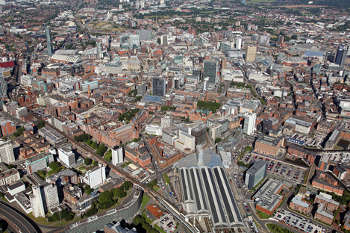Increased recognition of the role transport plays in providing access to healthcare and reducing social isolation and a renewed focus on the night time economy are key changes in the finalised Greater Manchester Transport Strategy 2040.
Following an extensive consultation, including 1,800 responses on the draft plans, the city region identified health, the economy and sustainable transport as areas in need of greater focus.

The regional centre (Manchester and Salford) from the air
The strategy states: 'We will work with partners, including through Health Devolution, to deliver transport interventions that improve the health of residents, including: increasing levels of physical activity; improving access to healthcare; and reducing social isolation.'
It also identfies a need to design the transport network carefully to support the 'vibrant 24/7 economy' of the regional centre, 'focusing on the needs of different markets at different times of the day and the week'.
The strategy envisages a rapidly rising population, tens of thousands of new jobs and a need for 227,000 new homes over 20 years, as set out in the Greater Manchester Spatial Plan.
The document predicts this will lead to 600,000 more trips daily on the city region’s transport network by 2035, which could result in congestion and overcrowding, ‘ultimately choking off investment and damaging prosperity’.
To guard against this, the document recognises the need to work with Government to develop new funding packages for the key infrastructure required, and a successor to the Greater Manchester Transport Fund.
The mayor of Greater Manchester, Tony Lloyd, said: ‘Having this framework in place allows us to shape and create a successful, resilient city region, ensuring the sustainable success of Greater Manchester for generations to come.'
He added: ‘Finalising our strategy is only the beginning. We are already working to deliver the first phase of activity outlined in these plans; building the new Metrolink line to Trafford Park and the Trafford Centre; creating new, enhanced interchanges in Ashton-under-Lyne, Bolton, Stockport and Wigan; and making improvements to walking and cycling infrastructure.’
The document identifies highways measures as an immediate priority to improve reliability and access across the wider city region and to the motorway network.
It also promises an immediate focus on improved access to key employment, education and training locations, bus and rail passenger facility improvements, town centre and regional centre access measures and neighbourhood connectivity schemes.
The increased devolution of powers and funding will allow Greater Manchester to explore ‘radical new opportunities to reform our bus services, and improve the way in which we manage our major roads and rail stations’.
TfGM's five-year delivery plan - published alongside the strategy - states that detailed work is underway to identify a preferred 'model of control' for taking on the management of rail stations.
Nearly two years in the making, the strategy aims to create ‘an integrated, sustainable and well coordinated transport system’ and in turn a 'cleaner, greener, more prosperous Greater Manchester'.
Register now for full access
Register just once to get unrestricted, real-time coverage of the issues and challenges facing UK transport and highways engineers.
Full website content includes the latest news, exclusive commentary from leading industry figures and detailed topical analysis of the highways, transportation, environment and place-shaping sectors.
Use the link below to register your details for full, free access.
Already a registered? Login